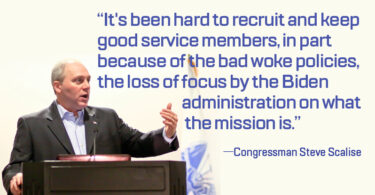The U.S. Army is in a minor panic.
The biggest branch of the U.S. military missed its recruitment goals by 15,000 soldiers last year, and this year is shaping up to be another heavy lift.
Enter: “Be All You Can Be,” the iconic slogan from the 1980s and ’90s, rebranded for a new generation.
“‘Be All You Can Be’ is a phrase that has inspired many generations of soldiers, and its promise still rings true today,” Army Chief of Staff Gen. James McConville said at the rollout of the latest reboot of the Army’s ad campaign. “This is the message for the moment and for the future.
If that smacks slightly of desperation, it’s not without reason: The Army is slowly shrinking. Last year, the Army requested funding for 473,000 active-duty soldiers but only ended up with 452,000.
This year, the Army is struggling to maintain that force level because realistically, that’s all the current recruiting climate can support, and even then, to stem the shrinkage will still require the service sign up 65,000 new enlistees.
The Army may be the poster child for recruiting woes, but it’s not alone in facing a historic challenge.
“This is something that we see happening across the entire Department of Defense to all of the services,” Gabe Camarillo, undersecretary of the Army, said. “It did not take one year to get into this situation. It’ll take several years to get us out of it.”
“Most of the trends that have created the present recruiting crisis will not change anytime soon, and if left unaddressed, they could soon threaten the ability of the all-volunteer force to protect the nation,” wrote retired Army Lt. Gen. David Barno and Nora Bensahel, visiting professors of studies at the Johns Hopkins School of Advanced International Studies.
Without urgent action, Barno and Bensahel argue, the military may find itself “continuing to involuntarily shrink” and “may soon be too small to address the growing security challenges facing the United States.”
Some of the reasons today’s youth are not attracted to military service are obvious, such as relatively low pay and easier jobs in today’s super-hot labor market.
But the challenge is not simply that fewer high school graduates want to join the military. It’s that fewer are in good enough physical or mental shape to enlist. . . . . (read more on Washington Examiner)
—
Or maybe there’s another clue: What Veterans are Saying








Leave a Comment